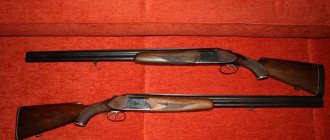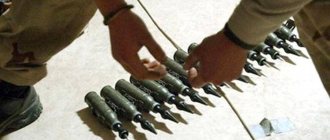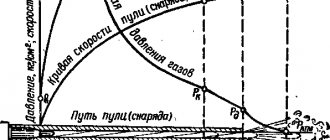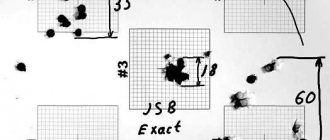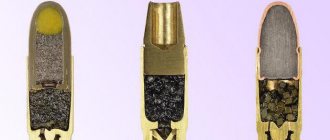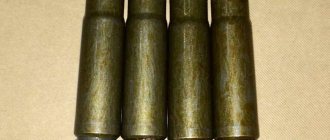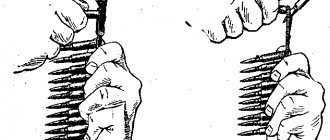Background
Wikipedia gives the second name for these bullets - unfolding, which is due to their design: when they hit soft tissue, the diameter of the bullet increases, which leads to greater lethality.
The British first began to use them in their colonial wars.
For a long time, handgun shells had the ability to flatten when they hit the enemy’s body.
This led to the fact that the wound channel was complex and the wounds were quite severe.
The bullets got stuck in soft tissue and were difficult to remove. In the 19th century, with the advent of new weapons and smokeless gunpowder, projectiles also changed and were made from harder metals.
Such cartridges easily passed through the enemy’s body, leaving a neat trace, and became deadly only when they hit vital organs.
This situation did not suit the British military and they tried to develop more dangerous bullets. An officer who served in India, Neville Bertie-Clay, succeeded in this by proposing to saw off the nose of the bullet.
Later, cross-shaped cuts were made on the shells, helping the metal to open like the petals of a flower, as in the photo, which gave the bullets their poetic name.
Moreover, the soldiers could do this on their own, because a strong knife is enough to make a cut.
Even when hollow point bullets became banned, they were not officially supplied to the arsenal of many countries, but soldiers independently sawed off the tip of the bullet and made cuts.
Also, to increase the “lethality”, the expansive cavity was sometimes filled with mercury; such mercury bullets had not only increased lethality, but also a poisonous effect.
Flowers of death. "Dum-dum" and other lethal bullets
The use of explosive bullets was officially prohibited by the Hague International Convention back in 1899, but even today they continue to be used in military operations. And American designers call them expansion cartridges used for hunting big game.
Modern expansion cartridges
Rifle weapons and their disadvantages
The appearance in the 19th century of a huge number of types of rifled small arms became a period of massive experiments, the purpose of which was to improve ammunition capable of, if not destroying, then certainly incapacitating a soldier of the enemy army with one shot.
In smooth-bore weapons, excellent results were demonstrated by lead bullets, which, when they hit the target, were flattened, causing horrific damage to the enemy. But the advent of barrel rifling, increasing the range and accuracy of the shot, changed everything. Lead bullets were deformed and torn from the rifling, and the accuracy of hitting targets dropped sharply.
The way out was the production of shell-type cartridges. In them, the lead core was protected by a dense copper, brass, cupronickel or steel coating, which tightly clung to the rifling of the barrel and gave the bullet excellent ballistic characteristics. They hit their targets accurately from a distance, but the wounds they inflicted were not terrible enough. And soldiers wounded even several times could continue fighting.
Modern shell cartridges of various types
Problems with shell munitions
The British, who fought colonial wars on almost all human-inhabited continents, were the first to notice the shortcomings of shell bullets. They were especially amazed by the endurance of the African natives and Maori warriors, who, even with several holes in their chests, continued to attack the enemy, falling only after accurate hits to the head or heart.
The first sign of discontent was shown in 1895 by British soldiers who fought in the Indian Khanate of Chitral, located on the border with Afghanistan. They stated that the ammunition they were given was ineffective since wounded Afghans did not fall after the first hit.
Reloading the rifles took quite a long time, and the advancing natives categorically did not want to die, from which the soldiers concluded that Her Majesty’s government had decided to save money by providing them with low-quality cartridges.
Captain Neville Bertie-Clay suggested a way out of the situation. He proposed producing slightly modified bullets for the .303 British cartridge, which was used as ammunition for Lee-Metford and Lee-Enfield rifles.
Various .303 British cartridge variants
The officer simply removed about 1 mm of copper alloy from the tip of a standard bullet. The lead core was exposed, and the effect of hitting targets exceeded even the wildest expectations.
The first batch of new cartridges was produced at the arms factory in the Indian city of Calcutta. It was located in the suburb of Dum-Dum, which gave its name to the most terrible small arms ammunition of that time.
Flying death
The new cartridges were tested in combat situations and demonstrated their incredible effectiveness. When the bullet hit the target, it stopped even the strongest man in his tracks. The wounded person was literally thrown back, and in most cases he could no longer get to his feet at all. Pieces of flesh flew off from his body to the sides, which is why the bullets began to be called explosive. But they were not torn apart inside the body, as many still think.
Penetrating wound to the jaw from a “dum-dum” bullet
During the Boer Wars, a number of photographs appeared in the press showing victims of dum-dum bullets. With a relatively small entrance hole, the exit was a huge lacerated wound, and after being wounded in the arm or leg, the limbs could only be amputated.
The British only needed to hit the native attacking them once to render him completely incapable of combat, causing complex bone fractures, ruptures of internal organs and numerous injuries to soft tissues. The vast majority of victims of the “dum-dum” bullet died within half an hour, unable to cope with the wounds received and the painful shock.
Stop the process of self-destruction of humanity
At the end of the 19th century, explosive bullets, like the machine guns that appeared, became the most terrible weapons of that time, which brought humanity to the brink of physical destruction. Some military experts compare machine guns and explosive bullets to modern nuclear weapons, which are almost impossible to defend against.
Even the British government realized how a future world war could end, the reality of which no one doubted even then. Together with 14 other leading countries of the world, the Hague Convention on the Prohibition of the Production and Use of Explosive Bullets was signed in 1899.
Explosive “dum-dum” bullets sold in every gun store
Within a few years, most other countries in the world joined this convention (do not forget that at that time huge territories were colonial possessions, and the total number of independent states was not very large).
It was decided not to ban machine guns that fired perfectly with cartridges with an intact bullet casing, but jammed with explosive ammunition. And they said their terrifying word on the fields of the First World War, literally “mowing down” the advancing chains. It’s even difficult to imagine how many people would have died in this war if the warring parties had also used explosive bullets.
Execution for "X" on a bullet
True, both the First and Second World Wars were still not entirely complete without the use of explosive cartridges. Despite the official ban, many soldiers made them in a handicraft way.
During the calm period before the battle, some military personnel of all armies, without exception, picked up files and sharpening stones. With their help, they ground off the tips of their cartridges, or made X-shaped cuts on them.
Such a simple manipulation turned an ordinary bullet into an explosive one. It was flattened when it hit the bones and opened inside the victim in the form of a “flower of death.” In battle, the use of such ammunition gave a serious advantage, but it was absolutely impossible to be captured. In all armies there was an order to shoot on the spot any prisoner who was found to have explosive cartridges or accessories for their manufacture in his pouch.
USSR explosive bullets
The Soviet Union also did not completely abandon the idea of giving its military personnel explosive bullets. Several design bureaus worked on the creation of domestic "dum-dum". Even prototypes of DD and R-44 ammunition were presented.
The main obstacle to their further production was the short firing range (300 meters instead of the required 500 m), as well as the low ballistic characteristics of the bullet. According to the leadership, the enemy could calmly shoot Soviet soldiers from a long distance, which, naturally, did not suit anyone in the USSR.
Despite the ban, large-caliber explosive bullets are still used in hunting large animals due to their stopping capabilities. Before the widespread use of pump-action shotguns, special forces soldiers used explosive bullets to kill terrorists in crowded places, especially on airplanes.
True, the powder charge in these ammunition was reduced so that the bullet did not “pierce” a person through and through and did not give dangerous ricochets.
Pistol cartridges SP-7 with a bullet with a plastic tip
Russian special forces still use Soviet SP-7 and SP-8 cartridges. They have a lightweight plastic core with six special notches applied to the leading edge of the shell, allowing the bullet to open in the form of a “flower of death” with six petals.
Incendiary explosive ammunition
To get around the ban, designers from different countries began developing ammunition whose bullets would actually explode into small pieces when hitting the target.
An explosive charge was placed inside the bullet capsule, which detonated upon contact with the target. In fact, a micro-explosion was heard in the victim’s body, multiplying the damage to internal organs. They are much more dangerous than the infamous “dum-dum”, but they have one very significant drawback, which designers still cannot eliminate.
Even the minimum explosive charge contained in modern explosive bullets can detonate at any time. This is especially dangerous during a military campaign. Military personnel can move on armored vehicles or dash, fall and crawl, and the detonation of even a small bullet can lead to serious injuries, putting a soldier out of action for a long time.
They are very expensive to produce, so they are most often used by snipers who engage a target with large-caliber rifles from a distance of several kilometers. Incendiary-explosive bullets from aircraft machine guns and anti-aircraft air defense systems have a similar principle of operation.
Off-center bullets
The Pentagon was the first to place an order for the purchase of a fundamentally new 5.56x45 mm machine gun cartridge, the bullet of which had a shifted center of gravity. During flight, such a bullet exhibits excellent ballistics, but upon contact with bones, it sharply changes its direction. In fact, she begins to somersault, causing monstrous internal damage to the victim. Often it breaks, leaving several fragments in the body.
Hitting a tree with just one bullet with a displaced center
The Soviet Union did not lag behind, introducing a low-impulse 5.45x39 mm cartridge, which is suitable for firing from the Kalashnikov AK-74 assault rifle and its later modifications. Due to the small air cavity in the front, the bullet's center of gravity is shifted back, causing it to tumble when it hits the target.
Such cartridges have much less penetrating power than 7.62 mm AK-47 cartridges, but inflict much more serious wounds on the enemy, leaving his body at an angle of 30-40 degrees from the original direction of the shot.
Modern fragmentation-penetrating bullets
Today, the production of ultra-effective small arms ammunition is gaining momentum. The Americans presented a version of fragmentation-penetrating bullets that do not open up, but scatter into several (as a rule, fragments). In this case, the bottom continues to move in the form of an independent destructive unit and tearing apart everything in its path.
The Americans presented a version of fragmentation-penetrating bullets that do not open up, but scatter into several (as a rule, fragments). In this case, the bottom continues to move in the form of an independent destructive unit and tearing apart everything in its path.
Such ammunition is proposed to be used in civilian weapons, primarily in pump-action shotguns. According to American authorities, they make it possible to more reliably protect the lives of US residents from attacks by criminals and terrorists. But we know that any civilian weapon very easily turns into a military weapon. And a warehouse stock of expansive ammunition may come in handy not only for special forces soldiers, but also for militants preparing to commit a major terrorist attack...
Operating principle and types
According to their design, expansive bullets are divided into:
- Semishell;
- With an expansive cavity;
- With plastic tip;
Based on their operating principle, they are divided into:
- Deformable;
- Semi-collapsible;
- Completely collapsing.
Wound from conventional and expansive bullets
The first ones, when they enter the enemy’s body, become crushed and increase in diameter. The shell of such a bullet is missing entirely or partially.
Semi-destructible and collapsible ones are equipped with transverse folds on the shell or funnel-shaped recesses (hollow point).
Once in tissue, they are torn into pieces, which produces an effect similar to a fragmentation projectile.
However, having become one of the most damaging projectiles, the hollow-point bullet lost range and ballistics.
Its action is most effective at close distances, and the accuracy of the sight is low.
But with so many injuries caused by the cartridge, this becomes less important. However, modern improvements in the form of plastic liners improve the aerodynamic properties of the cartridge.

